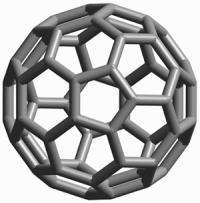A sponge-like molecular cage for purification of fullerenes

A work in Nature Communications presents a supramolecular nanocage which encapsulates fullerenes of different sizes and allows the extraction of pure C60 and C70 through a washing-based strategy. The work was coordinated from the Universitat de Girona. Contributors include Ramón y Cajal Researcher Dr. Inhar Imaz and ICREA Research Prof. Daniel Maspoch from the ICN2 Supramolecular NanoChemistry & Materials Group.
A fullerene is a molecule made of carbon that can be found in many shapes, such as spheres or tubes. They have a wide range of applications, highlighting their extensive use as electroactive materials in solar cells and with continuously appearing new uses in medicine. Any application, however, is limited in origin by tedious solid-liquid extractions (usually in toluene) and time-expensive chromatographic separations. Even the extraction of small amounts of purified fullerenes for research purposes becomes a complex process.
A work in Nature Communications recently presented a supramolecular nanocage synthesized by metal-directed self-assembly, which encapsulates fullerenes of different sizes. The study was led from the Universitat de Girona and included the participation of the UAB Department of Chemistry, the ALBA Synchrotron and the ICN2 Supramolecular NanoChemistry & Materials Group. RyC Researcher Dr. Inhar Imaz and ICREA Research Prof. Daniel Maspoch are among the authors.
The article provides direct experimental evidence for the 1:1 encapsulation of C60, C70, C76, C78 and C84, fullerene molecules consisting of 60, 70, 76, 78 and 84 carbon atoms respectively. Solid state structures for the caged fullerenes with C60 and C70 have been obtained using X-ray synchrotron radiation. With a washing-based strategy it is possible to exclusively extract pure C60 from a solid sample of cage charged with a mixture of fullerenes.
This tetragonal prismatic supramolecular cage with a high affinity for the inclusion of fullerenes, and a facile ability to release them by solvent washing of the solid inclusion compound, is an attractive methodology to selectively extract C60 and, with a lower efficiency, C70 from fullerene mixtures. Although the method cannot be used to produce big amounts of purified fullerenes, it provides an experimental platform to design tuned cages for selective extraction of higher fullerenes. The solid-phase fullerene encapsulation and liberation represent a twist in host-guest chemistry for molecular nanocage structures.
More information: Cristina García-Simón, Marc Garcia-Borràs, Laura Gómez, Teodor Parella, Sílvia Osuna, Jordi Juanhuix, Inhar Imaz, Daniel Maspoch, Miquel Costas & Xavi Ribas. Sponge-like molecular cage for purification of fullerenes. Nature Communications, 2014. 5, 5557. DOI: 10.1038/ncomms6557
Journal information: Nature Communications


















